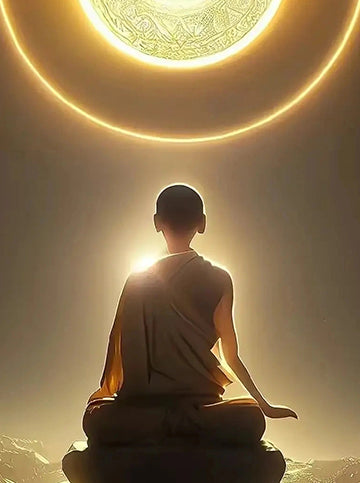The oldest anthology of poetry in Chinese tradition, The Book of Odes, recounts the tale of Chief Gong Liu, who bravely led an exodus of his people to the fertile lands of Bin in the year 1796 BCE. Upon arrival in his new domain, Chief Liu conducted a geophysical survey. He measured the shadow of the sundial to determine the cardinal directions. According to tradition, "sunshine and shade," as depicted in the poem, are the original forerunners for the terms "yin" and "yang."
In a nutshell, yin and yang represent all the opposing yet inter dependent energies of the universe. The tai chi, the symbol for yin and yang, provides a visual explanation. Comprised of half circles (but not semicircles) - one dark, the other light-each is at its greatest where the other begins, and as each diminishes the other grows. Within the dark half is a seed of light and within the light half is a seed of dark. Each gives rise and meaning to the other.
Yin (negative) and yang (positive) are forces, in constant movement, acting together to create energy. Just as night would not exist without day, we cannot have dark without light, nor shadow without sun. An underlying concept of Feng Shui is how to achieve balance between these two opposing forces within our own lives and environments.
In short, yang conveys everything overt, bright, active, masculine; yin is the more secretive, dark, passive, feminine state. In interior design terms, a room decorated in hot, positive yang colors would be bright red, hot pink, orange or vibrant yellow. Rooms such as the living or entertaining spaces of the home, which contain striking features such as metal sculptures, bright paintwork and bold feature walls, tend to be yang. Insertions such as mirrors, stone bowls, ceramics, hardwood floors and concrete are yang; as are ventilated, sunlit, sharply angled rooms.
A yin room, on the other hand, such as a bathroom or bedroom, is cool and passive. Colors in this category are soft, dreamy blues and greens. Organic, rounded, introverted, quiet rooms tend to be yin. Soft furnishings, fluffy rugs, throw rugs and wall tapestries are all yin. Each has the ability to affect moods, or the "feeling" you have when you step into a room exhilarated, relaxed, energized or subdued.
In the home, yang must be the dominant energy. Too much yin energy can be gloomy and oppressive. On the other hand, overpowering yang will lead to sleeplessness and an inability to concentrate and function efficiently. Where either yin or yang achieves dominance, an imbalance occurs. The balance of yin and yang encourages the effective, positive flow of Qi. It is this positive flow of Qi which is manipulated by effective Feng Shui, by correct interior design, which is itself facilitated by an understanding of yin and yang.
The trick to energizing a yin area is to charge it with a yang spot. Or to decrease an over exuberant yang area, ground it with some soft yin tones. If you have a hardwood timber or tile floor (yang), add the cozy warmth of a rug (yin) to balance it. If there's too much yang energy in the living room, cover the couch with soft cushions in gentle colors. Put up a wall hanging. Equally, if you have a dark yin room, the addition of bright flowers or an aquarium will provide it with much-needed yang energy.
A yin room, home or environment, is cool, passive and calming - such as this sideboard in an inner-city entrance. Colors in the yin category tend to be organic and fertile greens; soft, dreamy blues or pale violets. Organic, rounded, introverted, quiet rooms tend to be yin. Soft furnishings, fluffy rugs, throw rugs and wall tapestries are all yin.
In interior design terms, a room decorated in hot, positive colors such as bright red, hot pink, orange or vibrant yellow is yang. Yang rooms such as the living room, home office or kitchen are filled with energy, movement and discussion. Striking features or objects, such as metal sculptures, bright paint, lights, mirrors, ceramics and hardwood floors are yang; so are sharp angles and sunlight.
While too much yin energy can be gloomy and oppressive, too much yang energy, such as the glaring sunlight and stark whiteness of this room, should be balanced with Much -needed yin features such as soft green plants, art work or soft furnishings to help ground the energy.
This contemporary bedroom was too yang for rest, relaxation and romance, so the vibrant energy of the orange tones and hues was diffused by the application of soft, earthy yin coverings and cushions. Yang colors (especially bright orange) aren't good Feng Shui in the bedroom unless balanced sensitively with yin colors or shapes.
The trick to energizing a yin area is to charge it with a yang spot. This dark yin room was enlivened with much-needed yang energy by the use of burning candles, and a lighter bedspread and throw blanket. The window was also opened and curtains were tied back to allow for ventilation and sunlight.
The cozy warmth of a rug (yin) was applied to this concrete foot (yang), to balance the opposing elements. Apply this concept if you have a hardwood timber, tile or concrete floor; sparse walls benefit from a wall hanging, tapestry or painting.
Yin (negative) and yang (positive) are representative of all the opposite energies or forces of the universe. In constant movement, yin and yang act together to create energy. The symbol for yin and yang, the tai chi, makes it easy for us to understand. Comprising two halves joined together - one part dark, the other light - each gives rise and meaning to the other. Each is at its greatest where the other begins, and as each diminishes the other grows. Within the dark section is a speck of light, and within the light section is a speck of dark.

